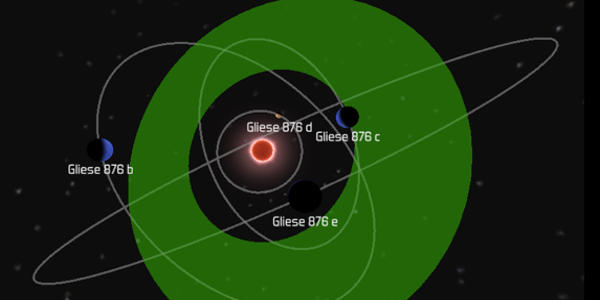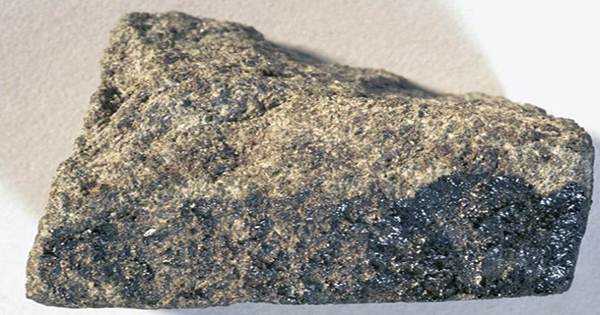Gliese 876 is a red dwarf about 15 light-years away from Earth in the constellation of Aquarius. It is a very cool and dim, main sequence red dwarf (M3.5 V). It is the closest star known to be a multi-planetary system. Compared with our Sun, Sol, this star may have about a third of Sol’s mass, possibly 36 to 39 percent of its diameter, and a bit more than a thousandth (around 0.0016) of its visual luminosity. As of 2011, four extrasolar planets have been found orbiting the star.
It is the third closest known star to the Sun which has a planetary system, after Epsilon Eridani (10.5 ly) and Gliese 674 (14.8 ly). However, if all wavelengths such as the much more abundant infrared radiation generated by red dwarf stars are included, the absolute bolometric luminosity of Gliese 876 is estimated to be much greater — 0.012 to Solar to 0.014 Solar.
Two of the middle planets are in the system’s habitable zone. The star is probably around 2.5 times as enriched as Sol in elements heavier than hydrogen and helium-based on the abundance of iron relative to hydrogen. However, they are giant planets thought to be like Jupiter. It has a rotational period of at least 40 days.

Distance and visibility
Gliese 876 is located fairly close to the Solar System. The star is neither young nor elderly. According to astrometric measurements made by the Hipparcos satellite, the star shows a parallax of 213.28 milliarcseconds, which corresponds to a distance of 4.69 parsecs (15.3 ly). It lacks a detectable, circumstellar dust disk and is chromospherically inactive, which suggests that it is more than one billion years old. Despite being located so close to Earth, the star is so faint that it is invisible to the naked eye and can only be seen using a telescope. However, its space motion is slow, which suggests that Gliese 876 is less than 10 billion years old.
- Constellation: Aquarius
- Age: 11 billion years
- Distance: 15.2 light-years
- Spectral class: M3.5
- Visual magnitude: 10.17
- Luminosity: 0.0016 * Sun
- Mass: 0.32 * Sun
- Diameter: 0.36 * Sun
Stellar characteristics
The planet was discovered in 1998. As a red dwarf star, Gliese 876 is much less massive than our Sun: estimates suggest it has only 32% of the mass of our local star. The surface temperature of Gliese 876 is cooler than our Sun and the star has a smaller radius. These factors combine to make the star only 1.24% as luminous as the Sun, though most of this is at infrared wavelengths. But new Hubble Space Telescope measurements of the star’s wobble, caused by the gravitational tug of the planet, firmly establish the planet’s mass as being no more than approximately twice that of Jupiter’s.
Estimating the age and metallicity of cool stars is difficult due to the formation of diatomic molecules in their atmospheres, which makes the spectrum extremely complex. The planet is only one-fifth the distance from the star as the Earth is from the Sun. Based on comparisons to red dwarfs in binary systems, Gliese 876 has a similar abundance of heavy elements to the Sun, estimated at around 107% of the solar abundance of iron. Based on a chromospheric activity the star is likely to be around 6,520 or 9,900 million years old, depending on the theoretical model used.
Like many low-mass stars, Gliese 876 is a variable star. It is classified as a BY Draconis variable and its brightness fluctuates by around 0.04 magnitudes. Though it is too far away to be photographed by present-day telescopes, the planet is presumably a gas giant world that might be encircled by moons, as imagined in this illustration. This type of variability is thought to be caused by large starspots moving in and out of view as the star rotates.
Information Source:
















